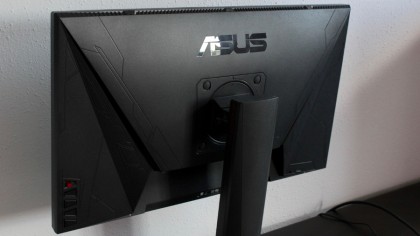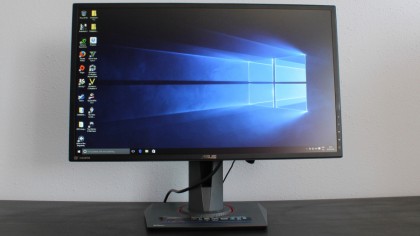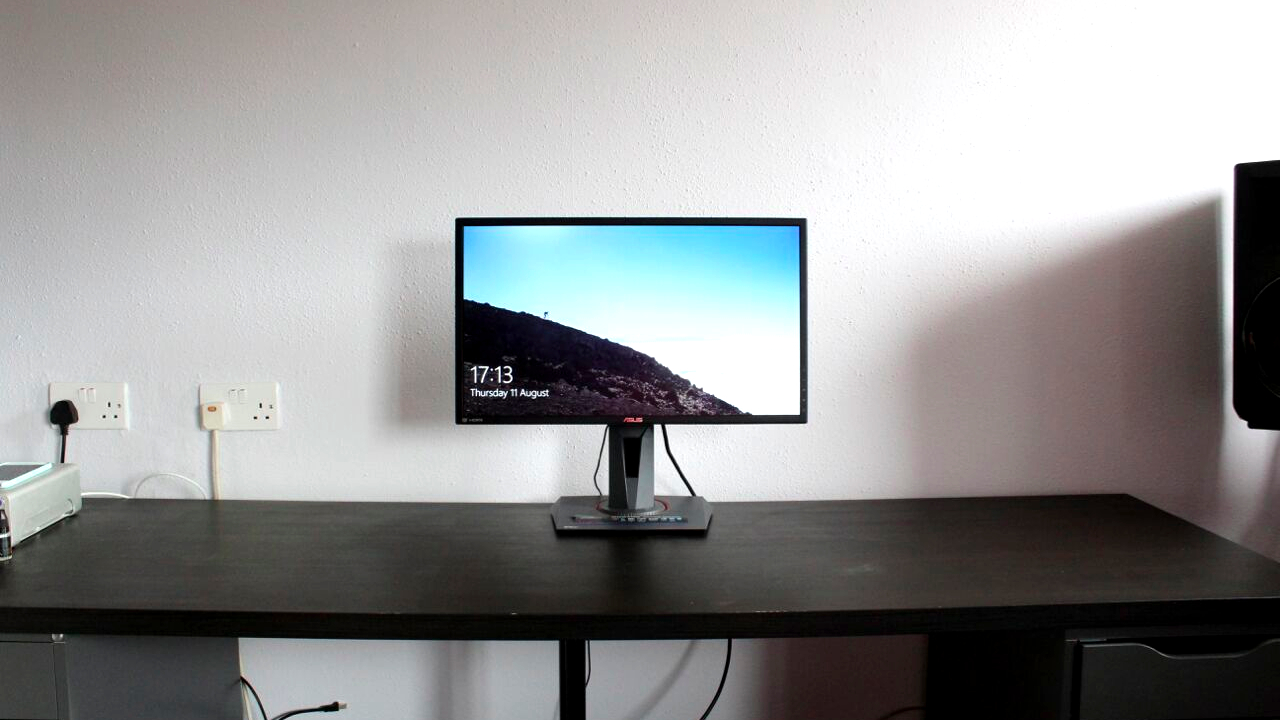TechRadar Verdict
For the money, you can't buy a faster gaming display that offers a 144Hz refresh rate. Some might be turned off by the TN panel, but it still looks darn good in the flesh. You won't be disappointed.
Pros
- +
144Hz refresh rate
- +
1ms response time
- +
Adaptive Sync
Cons
- -
TN panel
- -
Is 24 inches too small?
- -
Adaptive Sync for AMD and Intel only
Why you can trust TechRadar
The Asus MG248Q breaks many of the rules we've become used to with desktop PC monitors. It's a 23.6-inch display with a 1080p native resolution that's aimed squarely at gamers, with emphasis placed on features that will result in lightning-quick response times and fast refresh rates over image quality.
It uses a twisted-nematic (TN) panel, rather than the more advanced in-plane shift (IPS) technology. TN screens have fallen out of favor in recent years, as they can't offer the same viewing angles as IPS, so when they're viewed from an angle that's not quite head on the colors will appear ever so slightly less bright, or skewed. The 16.7-million colour TN screen in the Asus MG248Q is limited to 170-degree horizontal and 160-degree vertical viewing angles.
But by opting for a cheaper panel technology, Asus has managed to add some extra features while keeping the price within very reasonable bounds.

Speed demon
It has a 144Hz refresh rate, and TN panels naturally have a faster 1ms response time than IPS, which typically varies around 4ms at best, and above 10ms at worst. That's crucial for lightning-quick reactions in games, and there's also support for a technology called Adaptive Sync. These features offer some pretty fast performance when gaming.
Until the last year or so, monitors were a fairly mundane component in a PC build, without much major variation between models, aside from screen sizes or panel technology. Just about all 24-inch LCD displays now on the market can produce a picture that is good enough for general desktop use, and with falling prices across the board, they are relatively inexpensive as well. That frees up your PC building budget to be spent on other components - like a better graphics card or faster processor.

But for gamers, things have changed recently. There are now displays that offer 4K resolution, and there are ultra-wide, curved displays that dominate your desktop with screen sizes that go up to 35-inch. Displays now offer faster refresh rates, beyond the normal 60Hz that has been the standard since the invention of VGA graphics. And there are two competing technologies that improve 3D animation, by eliminating the visible tearing effect that sometimes happens in games.
Sync or swim
These are called G-Sync, for use with Nvidia graphics cards, and Adaptive Sync, which is the successor to AMD's FreeSync technology and works with both Intel and AMD graphics cards. They work by synchronising the monitor's refresh rate with the frame rate of your video card.
This distinction between competing technologies and the different video cards they support is a crucial aspect of the Asus MG248Q. If you have a GeForce, you won't be able to use Adaptive Sync on the MG248Q, but you will still be able to run games at 144Hz, which will offer a vastly superior gaming experience to a standard 60Hz display.
For the best gaming performance, it's no longer enough to simply own a very powerful PC. You also need a display that supports some of these features. We can't exactly demonstrate the difference when you're playing games on a display with G-Sync, Adaptive Sync, or a super-fast refresh rate, but take our word for it (or check it out in a PC shop) and you'll see Adaptive Sync is a very noticeable effect. Animation become buttery smooth, with no on-screen tearing in certain sense. Characters move in a far more realistic manner, and it's one of those subtle things that you get used to very quickly.

It can get expensive if you want all these modern features, though. There are now displays on the market which alone cost more than a typical mid-range PC. You can spend up £1,000 (around $1,309) for an ultra-wide curved display with a high refresh rate.
Perhaps, then, the killer feature of the Asus MG248Q is its pricing. At £269 (around $352) it brings down the cost of these top-end features, which were previously only available on displays that were priced beyond the level most people would spend on a PC monitor.
In addition to a 144Hz refresh rate and Adaptive Sync at a reasonable price, there's a bit more to the MG248Q. The design and build quality is notably rock solid and an immediately noticeable improvement on many competing displays in this approximate price bracket.
Asus has used the same dark grey and red styling seen on some of its more high-end displays, with a small red joystick and large chunky buttons sitting behind the panel to control the on-screen menus.
Out of the box, the MG248Q ships in two main parts, with the panel and stand requiring some simple assembly. The back of the display has a cool pattern of random lines and shapes over it for some variation on plain, flat plastic.
The screen tilts forwards and backwards, can be raised and lowered, pivots round into portrait mode and rotates on the spot, with a bright red groove around the base. There's a narrow cable management hole at the back of the stand and the plastic bezel is fairly thin, measuring just a few centimetres across. It's not as thin as some 'bezel-free' displays, but you'll still see the difference if you're used to an older monitor with a chunky plastic edge.
The offering of display inputs isn't especially generous. You get a DisplayPort 1.2 connector, HDMI and DVI. There are also built-in speakers, which unsurprisingly aren't very loud, but are clear, at least.
